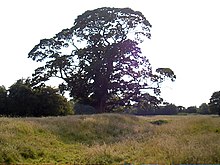Meaux, East Riding of Yorkshire
Meaux (pronounced /mjus/ "mewss"[1]) is a hamlet in the East Riding of Yorkshire, England. It is about 6.5 miles (10 km) north of Hull city centre and 3.5 miles (6 km) east of Beverley.
Meaux is part of the civil parish of Wawne.

Meaux Abbey was a Cistercian Abbey near Meaux.
According to A Dictionary of British Place Names the name 'Meaux' is derived from Old Norse Mel-sǽr, meaning "Sandbank-pool".[2]
Baines' History, Directory and Gazetteer of the County of York states that William the Conqueror gave the Meaux lordship to Gamel, who was born in Normandy at Meaux, a name he gave to the Holderness settlement which he populated with his own people. However, the Domesday Book records that in 1066 Ulf Fenman held the lordship, this transferring in 1086 to Drogo of la BeuvriËre, who was also Tenant-in-chief to William I. Meaux is recorded in the Domesday Book as "Melse". At the time of the survey the settlement was in the Middle Hundred of Holderness in the East Riding of Yorkshire. Meaux contained 29 villagers, 5 smallholders, 6 freemen, and 4 men-at-arms. There were 53 ploughlands, woodland, and 274 acres (1.1 km2) of meadow.[3][4]
In 1823 Meaux was in the parish of Waghen (alternatively 'Wawn'), in the Wapentake and Liberty of Holderness. Baines states that the Cistercian Meaux Abbey was established in 1136, and that only remains of a brick mosaic pavement had been found within "extensive" moats or ditches. Meaux population at the time was 74, with occupations including five farmers & yeomen.[4]
Mewes (also Mewis) is a fairly common family name in the North-East, and believed to be used by descendants of those who came to Yorkshire as soldiers commanded by Gamel.[citation needed]
References
- ^ Miller, G.M. (1971). BBC Pronouncing Dictionary of British Names. Oxford University Press.[page needed]
- ^ Mills, Anthony David (2003); A Dictionary of British Place Names, Oxford University Press, revised edition (2011), p. 322. ISBN 019960908X
- ^ Meaux in the Domesday Book
- ^ a b Baines, Edward (1823): History, Directory and Gazetteer of the County of York, p. 368, 369
- Gazetteer — A–Z of Towns Villages and Hamlets. East Riding of Yorkshire Council. 2006. p. 8.
External links
 Media related to Meaux at Wikimedia Commons
Media related to Meaux at Wikimedia Commons
